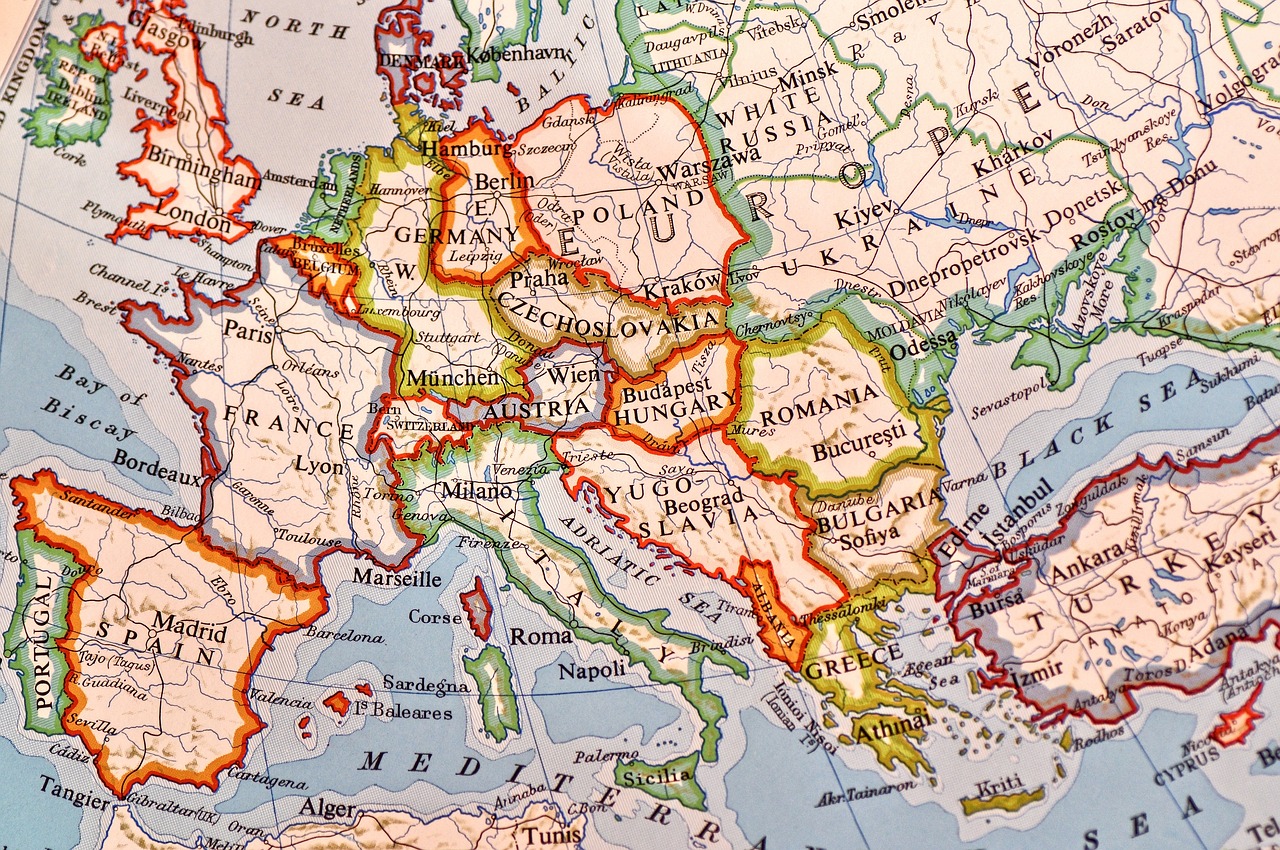Introduction
In this article we will discuss why people may want to find smoked catfish buyers in Europe, the benefits of selling your smoked catfish product to buyers in Europe; the types of smoked catfish buyers, where they are located, and how to find them.
We will identify some methods to employ such that instead of trying to find them, you could get them to find and locate you.
We will discuss the key differences between the various methods of finding these European buyers we have identified and how to choose which one fits you best based on what is important to you or your business.
We then propose a number of ways you can find these buyers.
We can assure you that many of these methods we have suggested are nontraditional methods that you probably aren’t already familiar with.
Although you may already be familiar with a few of the methods we have listed, we have described them in great detail and provided additional information to guide you as to how to use these methods and get results from them.
At the same time, other methods proposed are not so common, so we urge you to stick around and take a look at these.
They may just be what you have been looking for as a solution after you may have been frustrated trying other methods.
But we didn’t stop there as we still went the extra mile…
We actually combed through hundreds of listings to select those suppliers (yes actual names of organizations in Europe) that had anything to do with catfish in their public trading profiles and contacted them on your behalf.
Our goal was to see if there is already some relevant information, steps to take, and other preparatory questions anyone interested in selling smoked catfish to them would need to have or know.
We reckoned that that way, you won’t have to go through those steps again after reading this article.
And yes, we did find quite some interesting and useful information that we have included in this post and now sharing with you.
And that is not all…
Although you are here probably in search of smoked catfish buyers in Europe, we nonetheless took the liberty to also recommended how you may further benefit from some of the list of contacts we have shared here.
So as part of our European vendor’s engagement, we discovered that there was a need to gather some additional information and take some more actions that may help you.
So, this has prompted us to add the part we have labeled “Next Steps”.
and have shared these proposed actions towards the end after our conclusion.
Finally, we have also added a Q&A section at the end to cover some of the most common questions some of you may have about this topic. Of course, you are welcome to also ask your own questions using our comments box right after the end of the post.
All we ask is to be as brief as you can so other readers can easily pick up your question.
Now let us get to it…
Smoked catfish producers looking to find smoked catfish buyers in Europe can locate the buyers in the following ways:
- Online B2B Portals and Marketplaces
- Specialty Food Stores Abroad
- International Seafood Brokers
- International Seafood Buyer/Supplier Databases and Directories
- Use of Your Company Website
But first, why look for smoked catfish buyers in Europe?
The answer is quite simple as it is mainly a matter of economics.
The European market has a huge potential for smoked catfish
Specifically, recent data shows that Portugal, Germany, and Spain are the countries intaking almost 45% of the total smoked catfish being produced by Africa.
Producers who are able to sell their smoked catfish to buyers in Europe can expect huge profit margins compared to what they would get by selling their products locally.
That is not also surprising especially when you take into account the multiplier effect of exchange rate differences between the currencies of many of the smoked catfish-producing countries like Nigeria, and Ghana compared to those of the destination European countries using the dollar or the Euro.
A simple example would help us illustrate this:
Now, according to indexbox platform, the dried or smoked fish import price in the EU stood at $9,712 per tonne in 2020.
Meanwhile in Nigeria, the same product sells for about N5m per tonne. However, if you were able to sell the same one tonne produced in Nigeria to the EU and convert the price per tonne received to the Nigeria Naira you will get (Assuming the current parallel market rate of N759.33 to 1 USD); a total of N7.4m or an almost 50% profit margin.
Note though that we have not accounted for logistics and other expenditures.
Most of the producers of smoked catfish are based in one of the third world countries in Africa, South America or Asia.
These calculations and the multiplier effect impact are similar across these countries.
So now you can see why many more people are now looking to find smoked catfish buyers in Europe and other regions where they can sell these products at higher prices.
It just makes more business sense if you can sell in more profitable markets!
Exporting To Europe Confers Quality Status
While the desire to sell your products to European buyers is laudable, meeting the many requirements to qualify your products for export is no mean feat.
The upfront investment is usually huge in terms of fulfilling compliance requirements set by the EU for food quality and safe food practices. You may also see our previous post of “How to Export from Nigeria” for some coverages of these compliance requirements.
And that is not all.
There are also usually local components mandated as part of the overall EU export requirements.
An example of such a requirement is that your production and processing facility must meet specific food quality and safety standards through an inspection process in conjunction with the regulatory agencies in your local jurisdiction.
When you meet this requirement and are certified, the name of your facility would be listed in what is termed the EU Establishment list as shown below.
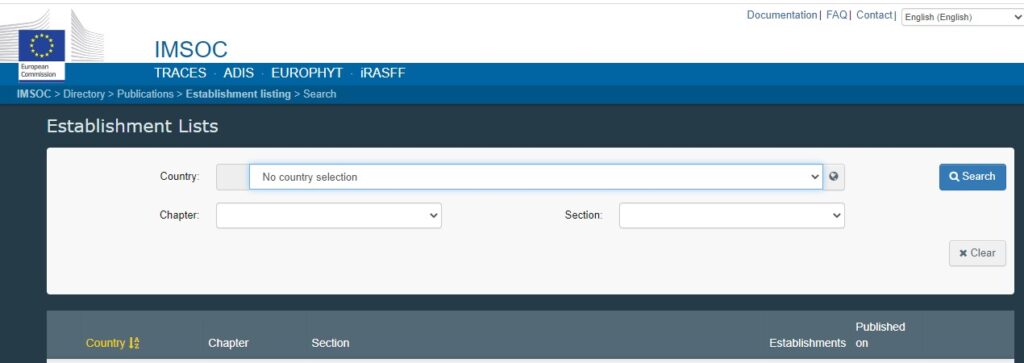


This is a searchable database that lists the names of companies and their facilities by country that have been certified to produce food products in different categories for the European market.
EU Export Capability Gives Market Leverage
Any company that is able to meet the export compliance requirement means they have a food quality and safety seal of approval that it can leverage even in its local market.
They are able to now charge a premium for their products and usually attract more customers due to what the qualification makes them become.
It is therefore of huge advantage (both economic and otherwise) if smoked catfish processing companies are able to work towards meeting these export requirements
Local Markets Lacking Differentiation
The sad reality is that at the very local level say in Ghana, Nigeria, or Cameroon, there is hardly any differentiation in the quality of the product from one producer to the other.
It is the same old, same old packaging and process employed, using similar types of non-standard or traditional processing equipment, and consequently with the same kind of result -indistinguishable products!
And it gets even worse.
The lack of food quality and safety standards regulatory enforcement in the production of smoked catfish in many of these third-world countries has not helped.
In these countries, the production of smoked catfish is now almost a race toward the bottom where for many producers, their only option is differentiation solely on the basis of price.
That is to say, by how much cheaper they can price their products compared to their competitor nearby.
This means that for any serious producer in these locations, aspiring to produce for export to buyers in Europe creates a unique opportunity for product differentiation and an ability to get more competitive prices for one’s product.
You may also be interested in: Where to sell Smoked Catfish
Objectives
Our goal is that after reading this article, you will be able to:
- Understand the benefits of selling your smoked catfish to buyers in Europe, know the different types of buyers, and hence decide which buyer may be suitable for your business based on real business criteria
- Know where these buyers are and how to contact them. know the different precautions to take when dealing with these buyers to reduce the risk of financial loss
- Be armed with enough information to be able to decide whether or not exporting your product to the European market is what you should pursue and to have additional resources you may need if you decide to go ahead
- What to do to put yourself in the enviable position to be found by international buyers without having to be looking for them and for international buyers, what you should do to ensure producers find you more easily so you don’t miss these business opportunities
Rising Global Smoked fish Demand
Smoked catfish producers can look forward to a projected increase in demand in the coming years.
This is sure good news for any producer.
According to a recent report by The Future Market Insights, in their Smoked Fish Market- Global Industry Analysis 2016 – 2020, and Opportunity Assessment 2021 -2031, they state,
“The demand for smoked fish has been rising in demand at a higher rate with significant growth rate over the previous few years and it is expected to increase constantly in the forecasted period that is from 2021 to 2031.
The smoked fish market is expected to be driven by rising demand for ready-to-cook packaged seafood items, rising per capita income, and the popularity of processed seafood in the coming years”.
So, with this level of expected growth, it is little wonder that smoked catfish is also one of the most sought-after seafood delicacies experiencing this growth on many continents.
While the global trend is upward, the yearly demand for the product within the EU has been dropping in the last four years …
The indexbox report estimates that for the fourth consecutive year, the EU recorded a decline in purchases abroad of dried or smoked fish, which decreased by -4.9% y-o-y to 338K tonnes in 2020. In value terms, dried or smoked fish imports declined to $3.3B in 2020
For producers in Africa, there is now a lot of local supply of the product without a corresponding increase in demand, thus making it very competitive to get good prices when you sell locally.
The traditional sales channels are also changing and making it easier for producers to reach farther markets…
According to The Future Market Insights report, “companies are now focusing their efforts on promoting their goods through online forums. This not only raises product awareness amongst customers but also becoming the preferred choice for most people. Because of the rapid rise in global digitization, online retailing platforms are expected to fuel market growth prospects in the near future”.
So what are the implications of these developments?
With the opening of online e-commerce channels, markets that were hitherto inaccessible to local manufacturers are now open to them.
Due to its long history of seafood consumption, it not only has a high demand for fish and fish products. But it has also established import and distribution networks for seafood products, making it easier for suppliers to sell smoked catfish to consumers in the region.
While on the flip side, Africa is one of the largest exporters of Smoked catfish. It has an abundant supply of catfish, which is a native species to the country.
Nigeria also has a thriving catfish farming industry, which provides a steady supply of fish for smoking and export. Additionally, the country has recently developed a reputation for producing high-quality smoked catfish, which has increased demand for the product both domestically and internationally.
Nigeria has been the top seller of smoked catfish, closely followed by Egypt, Ghana, and later Cameroon, Senegal, and Benin.
That being said, smoked catfish is one of those products that still hasn’t reached saturation. In fact, its demand is increasing by the day.
Some prefer it for its unique taste, some for its high protein source, while others enjoy it because of its ease of use in different recipes.
So although, to date, the production of Smoked catfish is still quite small withing the African continent compared to its potential, the dire economic situation in many of these countries especially the demand for foreign exchange makes the export of smoked catfish a viable business opportunity worthy of pursuing.
This, therefore, has created the opportunity for the export of the product to Europe, the US, Canada, and other continents.
See also: Health Benefits of Smoked Catfish
Smoked Catfish Buyers in Europe
There are different types of food product buyers
The type of buyers could be classified on the basis of the volume of products they buy and how frequently they buy. Two broad categories are listed here but are by no means exhaustive:
- Large Scale Buyers for the Retail market
These are normally wholesale buyers that distribute their products to supermarket chains.
They would normally operate large warehouses for stocking their consignment from which they organize the distribution to the retail outlets/stores.
Unfortunately, the popularity and hence global demand (volume) for the smoked catfish product has not yet reached the level of sophistication and maturity to interest these types of buyers.
- Low / Medium size distributors
These are normally those that do bulk purchases at a smaller level than the category above and seldom has their own warehouses. Many of these would take delivery from suppliers and deliver directly to the customer where the customer stores what they ordered and need.
Products distributed this way and by these categories of buyers may sometimes encounter lengthy stockouts as the distribution could be sporadic based on the limited volumes they can handle.
Some of their clients include specialty stores, corner shops, specialty/ethnic restaurants, etc
One way to identify this category of buyers is that they are usually not geographically spread as they have a much smaller geographical coverage
How to Find These Buyers
To know how to find these buyers, you must first identify the different places where they can be reached directly as in the cases of referrals, being listed in trade directories, or by knowing where to get information on how to reach them.
For example, this article is an example of the latter. By reading this article, you will obtain relevant information about how to reach some of the buyers you are looking for.
So presented below are some of the different places/ways you can use to find these smoked catfish buyers in Europe.
We will discuss each of them and highlight the specific attraction of each of these places/methods of locating them.
Smoked catfish producers looking to find smoked catfish buyers in Europe can locate the buyers in the following ways:
1. Online B2B Portals and Marketplaces
2. Specialty Food Stores Abroad
3. International Seafood Brokers
4. International Seafood Buyer/Supplier Databases and Directories
5. Use Of Your Company Website
Now let us examine each of these in more detail:
1. Online B2B Portals and Marketplaces
Online B2B Portals and Marketplaces are essentially online platforms housing details of suppliers, vendors, and related industry service providers whose public information (where information segregation is enforced) is open to the public (non-members) to view and search.
There are different types of B2B Portals and Marketplaces.
The different types of marketplaces could be organized by any or a combination of the following attributes:
- By how you get listed -whether you pay to be listed or you are listed for free
- Ownership of the platform -some platforms are owned and managed by Industry/market associations or government/industry regulatory bodies etc
- By the features of the platform -Is it just a directory listing supplier (basic company contact information with a brief description of services) or is it a marketplace (with e-commerce features where people may be able to place orders for your services directly from within the platform, conduct supplier identity verification, offering of payment services such as third-party escrow-like functions, etc
We will now discuss these types of B2B platforms and Market places and give examples to clarify them
Free to list B2B Portals / Marketplaces
These types of B2B Portals and Marketplaces extend open invitations to intending members to join. Many times, the joining process is not mediated or curated but usually a self-registration process of the members.
Also, after registration, there is hardly ever any process to validate the user entries for completeness, correctness, or validity beyond perhaps the basic email verification.
Even if the entries were correct at the point of registration, many of these types of B2B Portals hardly ever have any process to ensure users continually update their data in order to ensure the evergreening of the data.
Some common challenges with these types of portals:
- The information they contain is often incorrect, outdated, and hence not very useful
- In the absence of any registration process moderation, these entries are not verified and are prone to being falsified by the registrants for potentially criminal purposes
- Poor responses to enquiries. Our experiences show that business enquiries sent to members of these types of online B2B Portals and marketplaces get little or no responses
- When you do get responses, many of them make bogus claims in terms of who they are and what services they can render.
Some examples of these types of B2B Portals and Market places are Trade Seafood Directory and Euro Bloom Biz directory:
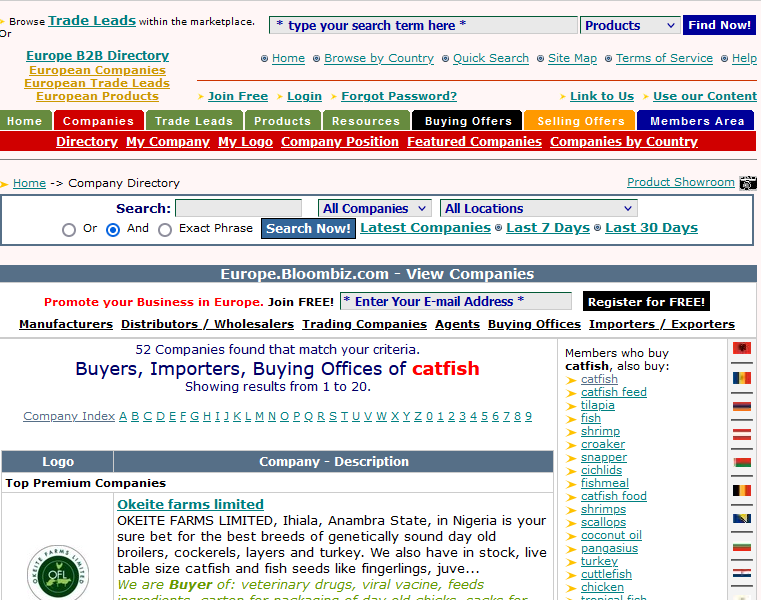

Pay-to-list Market Places
These are portals where members pay to have their companies listed. Usually, this includes a process of verification and the process of making payments serves as a way to also confirm some form of identity.
Some of the characteristics of these types of platforms are:
- Since the listing involves some form of payment, the company details are usually current and more complete that the free-to-list platforms
- Responses received from enquiries sent to members of these types of directories tend to be more on average than non-paid platforms. It can safely be assumed that any company willing to pay for the listing service is usually eager and ready to do business
- Many of these platforms tend to also offer additional services beyond the directory listing to justify the listing fees
Multipurpose B2B Portals and Marketplaces
These are the types of B2B Portals and marketplaces that offer more than just directory listings. Most often than not, the main additional service is payment mediation or escrow payment services.
The owners of these types of B2B Portals would usually act as the holders of the money while the goods to be purchased are in transit.
They manage this exchange between the buyer and seller by ensuring the money is exchanged ONLY after the buyer confirms the goods have been received.
Some characteristics of these platforms:
- Many more details are provided to these platforms by the members -this may include user identify verification of the accountable person within the company using government-issued IDs, bank account verification and other key identifying details the platform may request that protect buyers and sellers against fraud.
- Sellers and buyers go through this verification thus ensuring both parties involved in any transaction are protected. All new enquirers are required to be registered in order to go through the verification process.
- Just as above, responses received from enquiries sent to members of these types of directories tend to be more on average than a non-paid platform
How To Use Online B2B Portals and Marketplaces
Here are the steps to find buyers using online B2B Portals and marketplaces:
- First, decide on the criteria for the buyer you want. Do you want to search for buyers by their countries or by the products they offer to buy
- Click on the link to the B2B Portal and click the “search” button
- Put in the search criteria you already identified in step 1 above
- Read through the listings and select buyers that meet your criteria
- Contact the selected buyers and then send your enquiries
- As soon as you receive their response, engage in some means of verifying their claims using other methods such as searching through business registration databases, company LinkedIn profiles, asking them for referrals from companies they have previously done business with, etc
- Avoid any solicitation of upfront payment for anything. If you are being asked for an upfront payment, it is most likely a cam. Be wary and always ensure you do due diligence on anyone you want to engage in financial transactions within any country. Don’t be deceived. Be vigilant
2. Specialty Food Stores Abroad
Smoked catfish are usually within the category of specialty stores in many European Countries.
These are normally the stores that cater to a large extent the immigrant communities who tend to purchase the product the most.
This knowledge, therefore, provides an opportunity to locate potential buyers in Europe for it.
How to locate these types of specialty shops:
Use web search (Google) using the appropriate search phrase. A search using one or more of the following search phrases would return results that could be potential leads to start making your enquiry.
- “African markets in London”
- African markets in Holland
- African shops in the UK
- African shops in Belgium etc
An example of a specialty store African Food Products (A.F.P), Holland
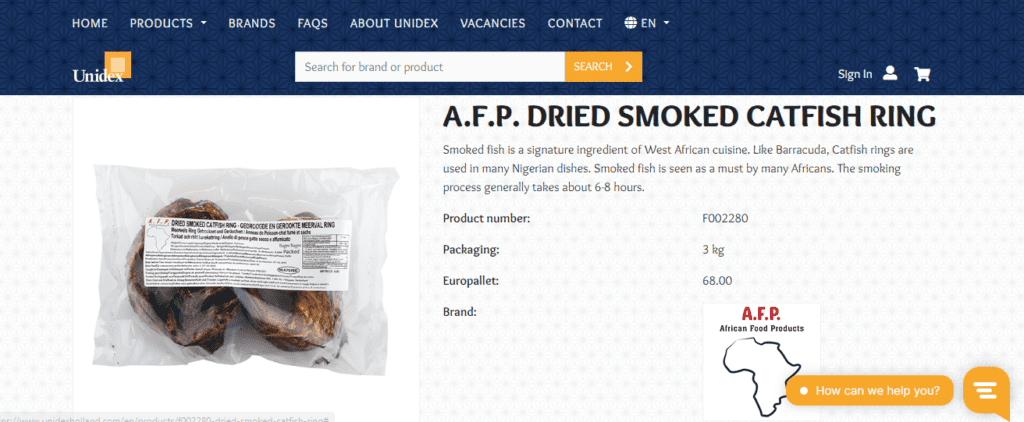

Recommendations on how to secure buyers using this method:
- Be patient. Recognize that many of these shop owners are not actively looking for sellers as they may already have suppliers supplying them if they already sell the product. So you must be patient if you do not get an immediate response or don’t get any response at all.
- Plan when to call. Many of these people do not have as much time to respond to emails. So it is advisable to first send an email and thereafter follow up with a phone call. If calling please take not of the time zone difference between you and the caller’s city and plan to call early on weekdays or late on weekends when they are less likely to be attending to customers. If you are calling on a Sunday make provision for those of them who attend churches and call sometime after 2 pm
- Get someone to introduce you It is usually a lot easier to get a warm introduction before writing the shop owners as they may consider your email spam and not respond. Get an acquaintance who lives in the same town (preferred) or country with them to visit the shop (preferred) and speak with the owner on your behalf to introduce your product to them before you call or send them your email. If they cannot visit, they can call them on phone. That way they will be expecting your call rather than a cold email or call from someone they don’t know (you).
- Send them samples. This is the most effective way you can get any shop owner to be interested in your product. Shop owners are usually quite wary of people who claim to have products to sell without seeing the products first. Find an acquaintance who can hand carry the product and show it to the shop owner and if the product is good enough in terms of quality and packaging, they would definitely want to speak to you about the purchase
- It is always a game of numbers: the more shop owners you call the more the chances of being able to secure a sale. So persist and get as many leads as possible using different European cities where we have largest immigrant populations
Challenges With This Method:
One of the biggest challenges with this method is that you may not be able to secure the attention of the shop owners.
However, an antidote to that is you securing an acquaintance who can help do the leg work and get you some introduction.
The second challenge may be your inability to send a sample to convince the shop owner.
For this issue, you must already have done your homework to determine the commercially available way to send smoked catfish out of your country and the requirements mandated by the regulatory agencies.
Since samples are in small quantities, it may be possible to send this as hand luggage with any of your friends, families, and buddies. However, this means you have not solved the problem because if you get a purchase order you will still be stuck in not having already established a way to commercially ship your product to your destination
So it is advisable that before embarking on any of the listed methods of finding buyers in Europe, you should have sorted out all your preparations that make your product “export-ready”.
That is one of the major considerations you must bear in mind.
In part 2 of this post, we will be covering more of the requirements for the export of smoked catfish in greater detail.
What quantity should you send as samples?
The practical recommendation would be to send about 1kg or about 4 medium-sized pieces weighing between 200-250 gm each. These should be packed as two pieces per bag making a total of two packets (parcels).
The reason for sending two parcels is simple:
By having two parcels, the buyer is able to make a comparison and hence assure himself that can get a consistent product if the two parcels are as similar as possible both in terms of sizes, appearance and eventually when he or she opens the parcel and tastes it.
3. International Seafood Brokers
Food brokers are very good resources that help manufacturers find potential buyers for their products. A broker is able to leverage their extensive networks and relationships with retailers to build selling opportunities for the manufacturer of the product while being paid for the match making service rendered.
For producers interested in finding new markets such as we are currently discussing, seafood brokers can be indispensable.
How do you find food Brokers?
Food brokers can be easily found in different ways.
Here are a few ways you can find them:
Use of the Internet (Google) Search
Food brokers can be found quickly by conducting an internet search using Google.
A search phrase such as “smoked catfish brokers UK” returns a ton of results as shown below:
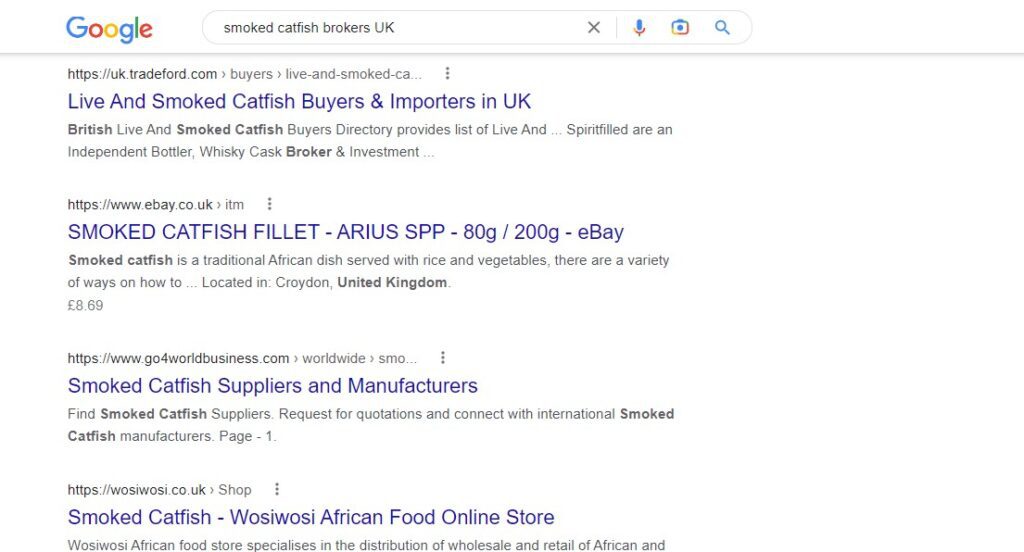

You may also be interested in: How to Start A Seafood Business
Search on Social Media Platforms
professional Social Media platforms such as LinkedIn can be useful for finding brokers. This can locate both individual brokers and companies who act as brokers.
But as always you must find other ways to validate and verify that the person or organization you are dealing with is genuine and authentic
Placing Targeted Ads on Global platforms
Online global platforms could be good places to place an ad for a food broker or even buyers themselves although these tend to be a bit expensive.
However, how much you plan to spend would depend on the anticipated vloumn=e of your business.
A sizeable business may be able to justify such expenditure knowing that you make the expenditure once to establish the relationship which then continues to yield benefits over time, thus paying for itself over and over.
According to the Centre for the Promotions of Imports from developing countries (CBI) which is part of the Dutch Ministry of Foreign Affairs, in their recommended “Tips for finding European fish and seafood buyers” they state that if you decide to take out a paid advertisement, seafood websites such as Undercurrent or Intrafish, would be suitable since they reach a large and global audience.
4. International Seafood Buyer/Supplier Databases and Directories
By far the most comprehensive seafood buyer/seller directories are those captured below. These links are provided and reproduced below courtesy of the CBI as part of their tips for finding fish and seafood buyers in Europe :
- Globefish – information on international fish trade from the Food and Agriculture Organization of the United Nations (FAO);
- Sea-Ex – Skype Directory for the seafood fishing marina and aquaculture industries;
- The Fish Site – website for the global aquaculture industry
- FIS – fish information and services portal
- Europages – multilingual European Union business-to-business (B2B) search engine, which includes a Buy & Sell marketplace
- Greentrade – the largest marketplace for producers, manufacturers and distribution networks in the organic industry, good for research by country, category, product and buyer;
- Seafood Source – news website and directory of seafood industry suppliers around the world
- Undercurrent – key news website for the global seafood sector
- Intrafish – key news website for the global seafood sector.
How to use this Method:
Unlike the other methods listed, the companies listed in these directories are very interested in doing business but their first act would normally be to do their due diligence to ensure you are a capable and credible potential business partner.
So what is important here is how you must first prepare to be able to meet this first hurdle of passing the “due diligence test”.
The due diligence test would typically be (as a minimum) to independently verify how credible you and your company are and whether you have the capacity to meet their supply requirements.
Here are some suggestions:
- Ensure you can be found online and in multiple ways. Again, this is part of the recommended tips from CBI. The basic requirement here is a minimum of a company professional website, a professional LinkedIn profile, and perhaps memberships of business associations such as your chamber of Commerce and Industry or similar organization.
- Ensure you have the export capability and are able to meet European export requirements. Some of the websites we have listed contain some of these requirements but we will be covering more of these in a letter post on the same subject.
- Ensure your product meets the desired export quality. It’s about the packaging, labeling and other food quality and safety mandatory requirements which are a must
- Familiarize yourself with your country’s export requirements. That is the first hurdle you have to cross. For example, in Nigeria, the very first hurdle you have to cross as an exporter is securing your Nigeria Export Promotion Council (NEPC) registration and obtaining the registration certificate. Afterward, you must also ensure the registration and certification of your production facility by the Federal Department of Agriculture, of the Federal Ministry of Agriculture, Abuja. While these may sound daunting, you could also secure the services of local food brokers who know what to do to help you prepare to meet these requirements. The fact that some of the companies in your country have met these requirements means you too can meet them if you work hard at it
- Avoid any form of dishonesty by trying to cut corners. The point when trying to establish this buying relationship, honesty, and building credibility is key. Any act of dishonesty in trying to falsify information about your company or its capability would always work against you. That is why preparation is key such that you are not tempted to take shortcuts in any way that might jeopardize the relationship and place you at a disadvantage
5. Use Of Your Company Website
According to CBI, it is almost now probably equally as important (if not more) being found than having to look for buyers of your product.
Since the COVID-19 pandemic, most companies and businesses now rely on using your internet presence as a way of verifying how business credentials.
A professional website is the first point of reference for potential business partners and hence should warrant lots of efforts to ensure that what it says about your company is what you want it to say.
While for many people this may seem trivial, it is nonetheless becoming a make-or-break tool for business assessment and prequalification for many potential business transactions.
But Why Should This matter?
First your website serves as a source of reference for information about you as a business.
It normally states who you are, where you are located how to contact you and is a static information which normally doesn’t change often providing the stability and comfort that people need to start doing business with you.
The absence of such static information then means people do not have an independent reference point to help them decide quickly on whether or not to engage with you except by what you may have told them which is as we know only “word of mouth”.
Many people may not realize that their assessment as a company starts by checking their email domain address and matching it with their website domain. Though basic that is the easiest way people can already determine whether you work for the company you claim you are working for.
In addition to these here are a few other good practices to ensure your company website can be used to help support your goal of finding potential partners to do business with:
- Ensure you have a professional-looking website.
- Make sure the website has sections that clearly describe what your company does where it is located, its history (how long it’s been doing business), and some information about its principal officers
- Make sure it has information about how to contact you. Websites these days act as a source of lead generation and people’s inability to reach you means you are not in business.
- Designate someone to check periodically that the contact form on your webpage works. Many times, the web form fails and nobody is aware. People who are then genuinely trying to reach you are then unable to do so
- Ensure regular review of messages received from enquiries on your web form. Many companies have those web forms where potential customers and partners can reach them but they do not take advantage of that and hence lose many business opportunities. Make sure one or two persons (better if at least two people) are assigned to review inputs from the contact form
- Make sure the information contained in the website is updated and current. See the website as an integral part of your business and its content should not lag behind the business
Challenges Using This Method:
Non-Functional / Not Updated Website
The usual problem businesses tend to have is that they see themselves as not technically inclined and hence tend to shy away from addressing their website issues.
If that is not the case many times, they do not understand the value add the website brings to the business and hence they neglect it.
Occasionally the SSL certificate for the site may expire and become inaccessible especially for those using Google Chrome.
This may last for a while and nobody within the company may be aware that is happening.
If that is not the case, events that were advertised for a certain date in the past may still be featuring prominently on your website as if it is still going to happen in the future.
Such a situation gives customers and potential partners the impression that the business is inactive and could create doubt about your credibility.
See also: How To Make Smoked Catfish Business Plan Great
Smoked Catfish Buyers -Extract from a B2B Online Portal (Listed by Country)
Listed below are specific companies that are either agents, wholesalers, importers, or exporters of catfish products of various forms. Some of these could be interested in importing smoked catfish into Europe.
EUROPE
Smoked Catfish Buyers in Europe
List of companies in Europe who trade catfish products as agents, wholesalers, and brokersUSA and Canada
Smoked Catfish Buyers in USA/Canada
| S/No | Company | Country | Brief products/services description |
|---|---|---|---|
| 1 | Big Blue Ocean LLC | USA | Big Blue Ocean LLC specializes in fresh H&G tuna, swordfish, wahoo and mahi and whole gutted snapper, grouper, corvina and cobia, as well as farmed salmon, bronzini, etc. Tuna All sizes. All Grades. Fresh: HG, Loins. Frozen: Saku, Loins. Swordfish All sizes. Fresh: HG. Frozen: Loins, Steaks. A family owned company for over 40 years, we pick up daily at MIA and FLL airports, grading and distributing throughout the USA from our own warehouse |
| 2 | Western Edge Inc. | USA | Over twenty year history of imports into the USA market for tilapia, catfish, shrimp, tuna, swordfish, barramundi, sea bass, ocean perch, redfish. |
| 3 | Maritime Products International | USA | Our specialties include Scallops, Catfish and Crawfish from China. We also carry Whiting, Sea Trout and Flounder from South America. |
| 4 | Empowermint . com | USA | We have tremendous contacts in the food service sectors in America. We are looking for direct fisheries and producers of organic Tilapia, Shrimp, Catfish, Salmon, and other aquaculture species. We also are looking for Fresh/Frozen/IQF Crab, Shrimp, Lobster, Scallops, and Whole Fish/Fillets/Loins. |
| 5 | San Link Inc. | USA | Seafood wholesale & distribution company handling frozen fish, smoked products and seafood specialties including caviar. |
| 6 | Bemka Corporation | USA | Import directly from the sources and distribute to high end food services. Sturgeon Caviar, American caviar, fish roe, king crab legs, crabmeat, smoked salmon, smoked fish and frozen seafood. |
| 6 | Toronto Starlit Business Import-Export Ltd | Canada | Seafood trading company, mahi, hake, sardines, anchovies, sea bass, sole, frozen, canned, smoked and marinated seafood products. |
| 8 | Canada | Canadian fish exporter. Licensed to import as well. License to export caviar. Fresh and frozen salmon, albacore tuna, halibut, black cod, sablefish, Arctic char, spot shrimp, smoked products, Salmon Roe/Caviar, Sturgeon and Paddlefish Caviar |
Middle East
Smoked Catfish Buyers in Africa/Middle East
| S/No | Company Name | Country | Brief Description of Products/Services |
|---|---|---|---|
| 1 | Ideal Marine Products LLC | Oman | red seabream, red grouper, amber jack, yellowfin tuna loins, greasy grouper, baby shark, barracuda, parrotfish, catfish, croaker, Indian mackerel, cuttlefish, sweetlips, CO treated yellowfin tuna loins, steaks, saku, |
| 2 | Nile for E-Commerce & Marketing | Egypyt | Importers, exporters, wholesalers and agents of croaker, tuna, king fish (Spanish mackerel), red mullet, grey mullet, tilapia, trevally, emperor, parrot fish, najil, grouper (hamour), red fish, crab, slam, oyster, ribbon fish, sole, silver carp, silver eel, cat fish, bream, red sea bream, sea bream, reef cod, octopus, squid |
| 3 | Jaslam Trading Company LLC | UNITED ARAB EMIRATES | We import and distribute all kinds of high quality sea foods in middle east from all over the globe. Our main products include fresh water fishes like rohu, tilapia, pangasius and sea water fishes like king fish, pomfret, mackerel, tuna, milk fish, red snapper, grouper, squid, lobster, cuttle fish, and shrimps include HOSO, HLSO, and PDTO & PD |
Asia
Smoked Catfish Buyers in Asia
List showing smoked Catfish traders in some Asian countriesSee also: How To Make Catfish Tacos
Other Ways to find Smoked Catfish Buyers in Europe
While we have listed many of these companies who could potentially be looking to purchase products from you, there are still other ways to still connect with these potential international smoked catfish buyers.
The first of these is by registering your company with international seafood trading portals or platforms.
Just like we have done here by searching through thousands of entries in some of these platforms to find suitable buyers, that is how potential buyers look for potential suppliers of the product they are interested in.
So, whereas one way of getting buyers is to look for them, another equally efficient way is for the buyers to locate you themselves by searching for you in any of these seafood trading portals. This is one way the CBI also recommends to sellers looking to contact European smoked catfish buyers in their “Tips for finding European fish and seafood buyers“
As we have already seen, many of these portals provide free listing and hence enable any genuine producer of smoked catfish from any part of the world to be found by anyone looking for suppliers.
The second way to be found by the buyers is to be registered with a seafood broker.
You could find international brokers or those located in a particular country or region you may be interested in.
The seafood trading platform contains a lot of seafood brokers and agents specialized in the wholesale import and export of these products, and you can search these listings by country and by seafood type.
So, whether you are looking for smoked catfish buyers in Europe or sellers in the smallest town of China, using search engines like Google, social media like Facebook, or navigation apps like Google maps, can also be helpful in locating potential buyers.
Last but not least, ask for recommendations from friends and family living in many of these European countries or from those producers around you who may already be involved in exporting the product.
These people can always be good referrals for you to launch your smoked catfish export.
As we have demonstrated, there is a growing global demand for smoked catfish and if you search hard enough, you will find the best Smoked catfish sellers and buyers who may be interested in buying from you!
Good luck!
You may also like: Where To Sell Smoked Catfish -And Get The Best Price
Conclusion
This is the first PART of a multi-part post focused on helping smoked catfish processors from developing countries find smoked catfish buyers in Europe.
Experience has shown that many processors from third-world countries have challenges finding buyers to export their smoked catfish to in Europe and similar places.
This post has focused on the same three things as the Centre for the Promotions of Imports from developing countries (CBI)says in their tips as important in finding buyers: making sure that buyers can find you online (nowadays maybe more important than you finding them), exploring the different types of buyers that might be interested in your products, and narrowing down those buyers to the ones with the highest potential.
However, as we have often found out, the issue is usually that many producers are unaware of, unable to or unwilling to meet the stringent phytosanitary and other import compliance requirements for exporting smoked catfish products to many of these destination regions or countries.
In PART 2 of this post, we will be examining the various requirements for exporting smoke catfish to some of these regions like Europe, Canada, and the USA.
So do well to subscribe to our newsletter so that you can be notified as soon as the post is published.
You may also like: Here Are Some Rare Smoked Catfish Uses and Benefits
As you have seen listed here, there are very many wholesalers, agents and brokers involved in the trading of these smoked catfish products.
These people are always ready and willing to patronize businesses that have good quality products that conform to acceptable food safety and other export standards.
Unfortunately, many producers are unable to meet these quality requirements and so cannot take advantage of these export opportunities.
Where are you on the journey to export your smoked catfish products to Europe or anywhere else outside your country?
What challenges are you experiencing (if any)?
How can we be able to help you on your journey?
We love to hear from you! We may just be able to support you on this journey to smooth the export of your products outside of your country.
Use the comments box to share with us your experiences.
Next Steps…
You can also use the comment box to let us know what specific questions you still have about finding smoked catfish buyers in Europe or any other country. Please be brief when you ask your questions.
If we find any recurring questions, then we may include them as part of the Q&A for this post or the upcoming part 2.
We are also considering initiating regular live events where we will bring in some experts to answer questions relating to smoked catfish export or similar issues and provide additional information as may be needed.
So watch this space!
Don’t forget to subscribe to our Newsletter so that you can get the notification for the Second Part of this article and additional information on when the planned live sessions would commence.
Smoked Catfish Buyers In Europe -Q&A
Question 1: Is smoked catfish still banned from being exported from African countries into the EU?
Answer 1: There is no total ban of Smoked catfish from African countries. However, the European Union now has a list of countries from only which smoked catfish can be exported to the EU. Some of the countries included in this list are Nigeria, Angola, Morocco, Benin, Egypt, and Ghana to name a few
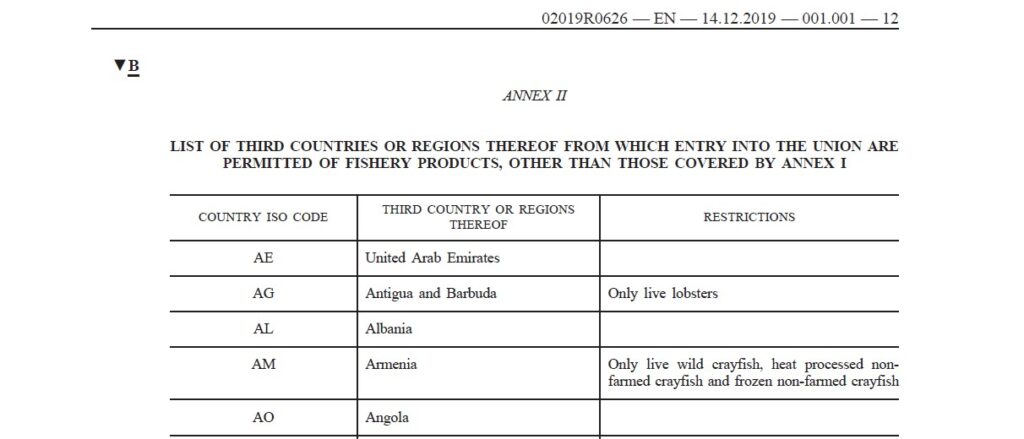

Question 2. What is one of the key steps smoked catfish producers in any country must take to be able to export products to the EU?
Answer 2: You must have your processing facility inspected and certified by your local Agriculture/Aquaculture inspection agency of your country which will then support your application for your registered facility to then be included in the EU establishment list



Question 3: What is the cost per tonne of smoked catfish in Europe?
Answer 3: Smoked catfish costs $9,712 per tonne
Question 4: What is the best advice to anyone considering exporting smoked catfish or any food product into the EU?
